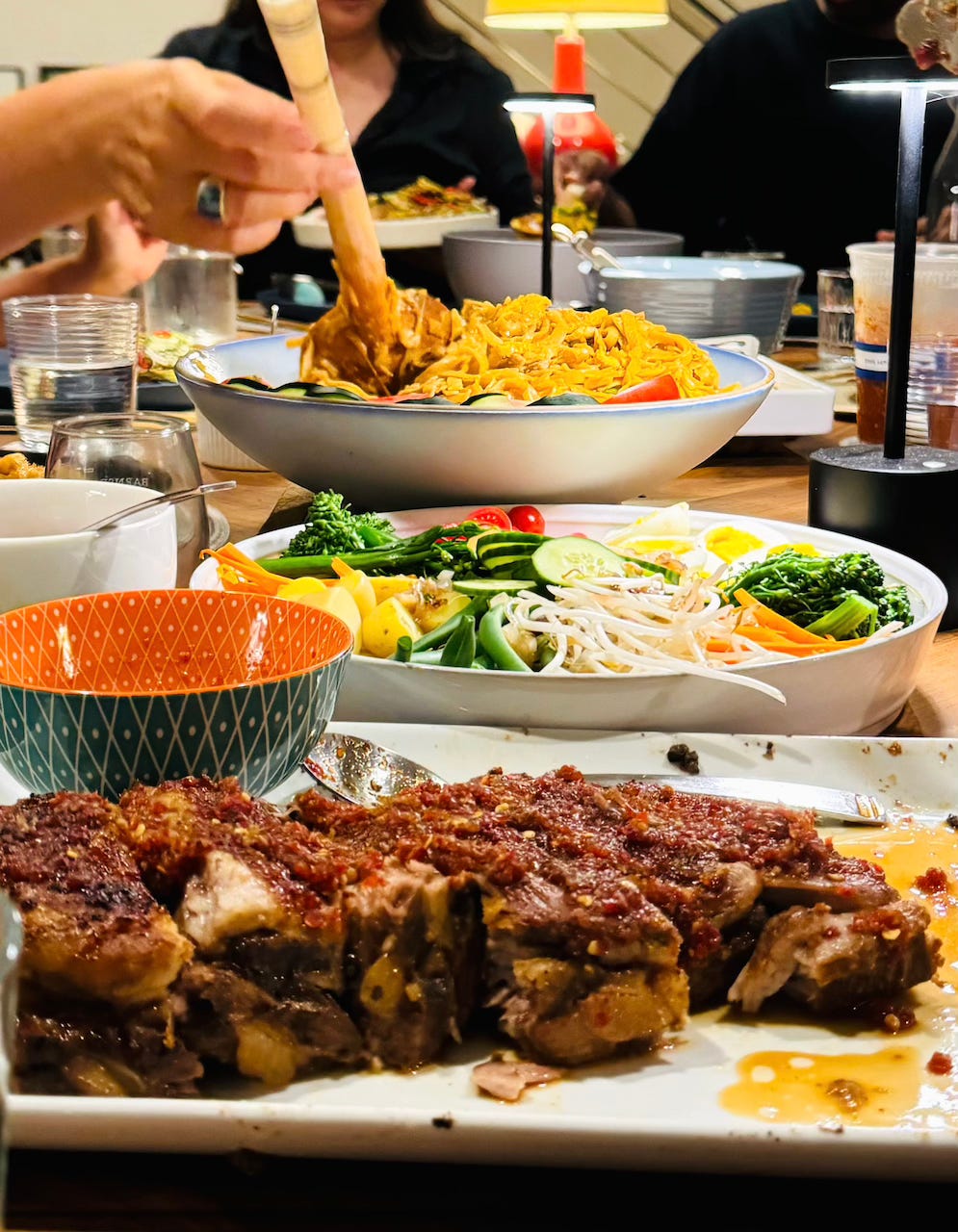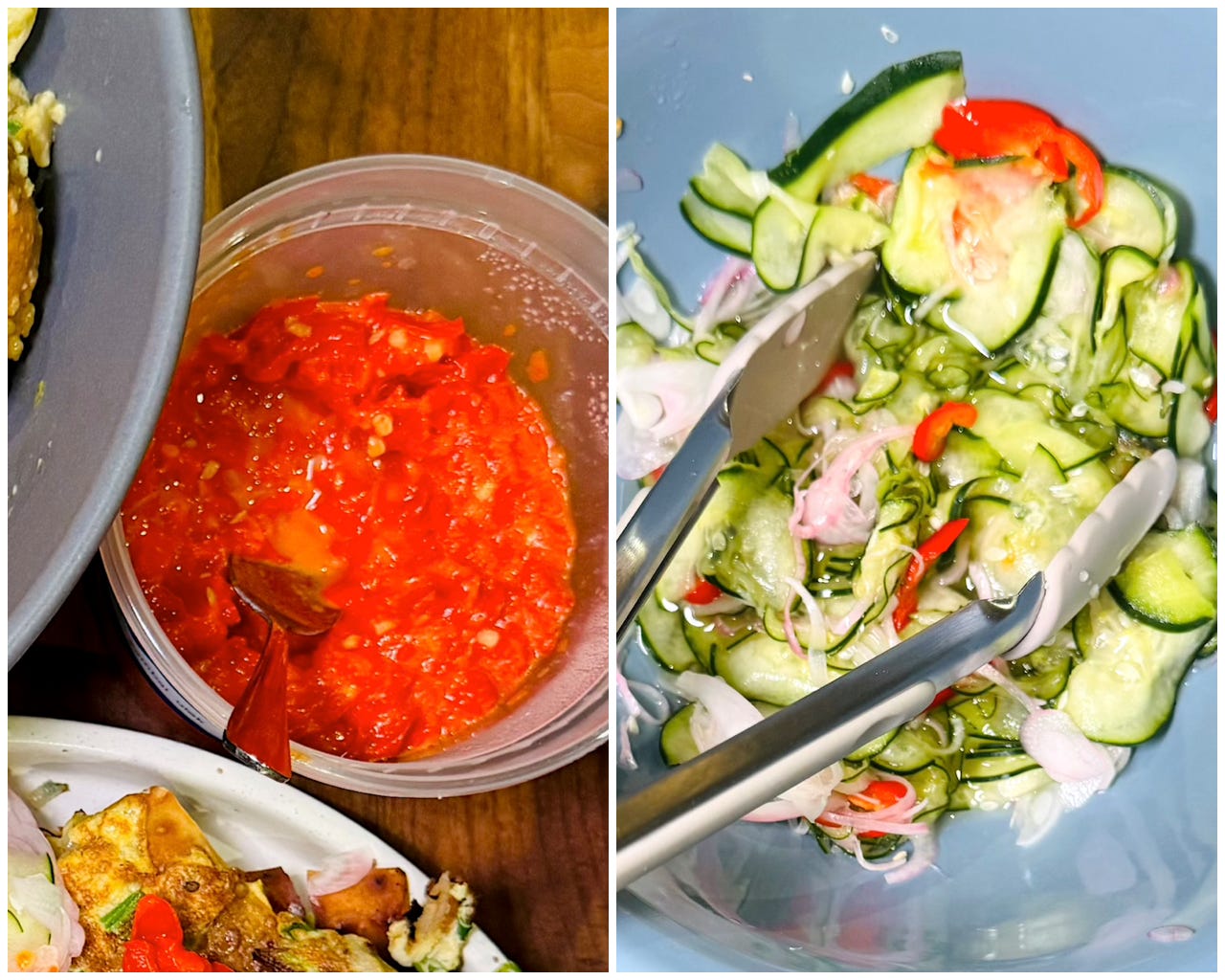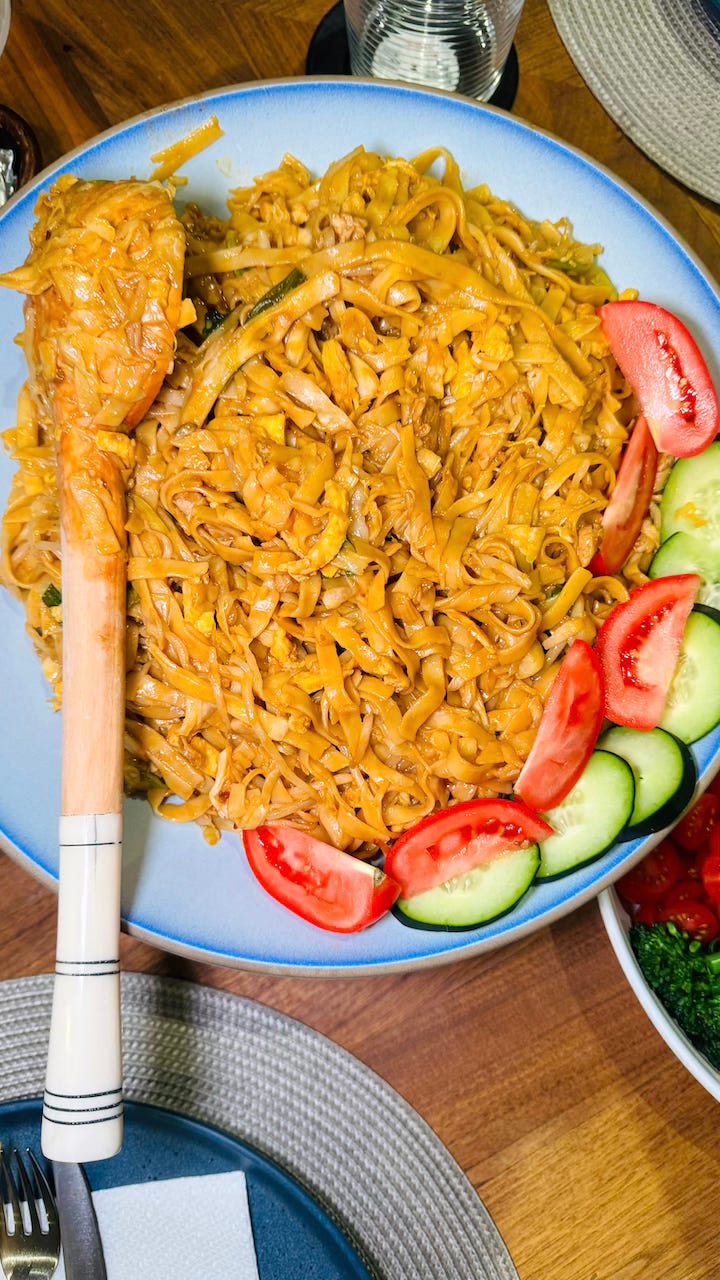In June of 2022, my friend Judy and I went to a local restaurant, Simpang Asia, and enjoyed some classic Indonesian dishes. I don’t remember exactly what we ordered, but I do recall there was nasi goreng (fried rice), martabak telor (flatbread stuffed with egg, scallions, and beef), and ikan bakar (girlled fish). All of it was tasty and bright and vibrant, and I felt inspired to dig into my Indonesian cookbook, Coconut & Sambal by Lara Lee.
Coconut & Sambal was a critical darling when it landed in bookstores in late 2020. I eventually nabbed a copy of it in February 2021, and by the time our Simpang Asia lunch rolled around, Lee’s book had sat on my shelf of shame, untouched, for a whopping 16 months. It seemed as though the time was finally right for us to dive headfirst into this Southeast Asian tome.
Judy and I pledged to organize an Indonesian cooking night tout-suite. But as the summer of 2022 unfurled before us, our grand plan wound up in social purgatory. It was something we wanted to do, but we were both too… lazy? Distracted? Unmotivated? … to actually plan it.
We tried to inject fresh momentum by looping in other friends - namely, our fellow kitchen denizens Sylvia and Derya - but Indonesian cooking night remained in a sad category of “Oh yeah! We should do that!” We kicked it down the line month after month after month after month.
But finally, two years and seven weeks after our Simpang date, Indonesian cooking night became a reality. Over the course of three days, we divvied up recipes, visited Asian markets, and bought more long, red chili peppers than you could ever imagine. There was also much discussion about kecap manis: what is it? Does anyone have it? And how do you say it? (the answer: sweet soy sauce, and it’s pronounced key-CHAP man-is)
In the end, all the parts came together to a magnificent whole. Here’s what we made.
Sambals, sambals, sambals (and one pickle)
Lara Lee describes sambal as a “hot relish that originate in Java” and states that “for most Indonesians a meal is not complete without it.” No surprise that “sambal” winds up in the book’s title, let alone most of the recipes.
For our meal, I wound up making three different sambals. First, ground chilli sambal ulek (or oelek). This is the sambal that I’m most familiar with. In fact I hoard it. True story: I auto-buy any jar of sambal oelek I see, mainly because when I need it, I never seem to find it in any store. And I need it a lot.
Thanks to this book, I’ve learned I can just make it. The process is beyond simple: boil 18 long red chillies in salted water for about 5 minutes and then puree in a food processor with vinegar, oil, sugar, salt and pepper. A mortar and pestle is the recommended technique, but when you’re pushing out multiple sambals, sometimes you just have to rely on modern technology.
This homemade sambal oelek was wonderful. Shockingly red, tangy, and warmly spicy, it later made a bold contrast to my homemade martabak telur. My only note was that it read a bit salty on first blush, but after several hours, the sambal mellowed into a beautiful condiment.
I also whipped up a double batch of tomato sambal, which Lee describes as “a beginner’s guide to sambal.” This one required 20 long red chiles (or 40, since I was doubling - and if you’re counting at home, we’re now up to 58 long red chilies on the counter). This sambal is almost like an inverse of ulek. We start by pureeing in the chilies with garlic, ginger, shallots, and cherry tomatoes. Then we cook the mixture in oil for about ten minutes, allowing it to thicken and darken. When the sambal is done, we add some brown sugar and tamarind paste, and then it’s time to season. Without salt, the mixture tastes sour and even bitter. But I salted then tasted then salted until the flavors suddenly came together magnificently. This sambal was amazing.
My third sambal was a Fresh Balinese Sambal Matah. I always thought sambals were pastes, but here Lee introduces us to something that lives between relish and pickle. Sambal matah is sliced shallots, julienned ginger, garlic, diced long red chilies (only two this time), sliced lemongrass, and sliced Makrut lime leaves. It’s all seasoned with sugar and lime juice, making for a sweet, zesty, and wildly intense bite. On its own, maybe too intense. With something like fish, a success.
Lastly, the aforementioned martabak recipe called for a cucumber, chili, and shallot pickle. This was a breezy - and fairly standard - pickle that came together in ten minutes and definitely punched above its class. I’ve made a lot of these sorts of quick pickles over the years, and this was one of the best. I don’t know what the x-factor is — maybe it’s the ratio of vinegar to sugar to salt — but it was a hit.
Martabak Telur (Egg and Spring Onion Martabak)
One of my favorite apps at Simpang Asia is the martabak, a fried square of egg, onions, and flatbread. Lee has two recipes for it in Coconut & Sambal — one with lamb, one vegetarian. I opted for the latter.
First I made the egg mixture by beating several eggs with fried shallots, fried garlic, sliced scallions, and salt in a large measuring cup. Next, I was supposed to roll out some martabak dough, but in the spirit of saving time, I opted for Lee’s variant, which subs in two large sheets of wonton wrappers instead.
Cooking the martabaks was a breeze. First, put some oil in a pan. Drop one wonton sheet in, and as it bubbles to life, brush the top with a thin film of oil. Then add a second sheet on top and brush that one as well. The oil adheres the two while they cook, creating a thickness that I imagine mimics martabak dough.
Once browned on both sides, pour some egg mixture on top - just enough to cover it — and let it cook for a minute. Then flip the whole thing over, add more egg, cook another minute, flip again, and cook until the bottom is no longer wet and raw.
All in all, each martabak took about 4 minutes of effort on the stovetop. I really enjoyed this recipe, partially because it was so simple to make, but also because it was a joy to eat… with a few caveats. First, this is really something you want to eat when it’s fresh from the pan. It’s fried, and fried food doesn’t sing when it sits around for a while — which is exactly what happens at a potluck. The good news is that while its crispy elements quickly became soft at the table, the flavor remained still spot on.
The second caveat is that you really need to enforce a pickle and sambal agenda. Lee recommends serving the martabak with sambal to dip and cucumber, chili, and shallot pickle as an optional side. Don’t give your guests an opportunity to ignore these condiments. Both sides offer acidity and brightness to cut through the heaviness of fried egg. Neglect either of them at your peril. Yes, the martabak is tasty in its bare state, but like a good outfit, accessories take it to the next level. That’s why I made the executive decision to dollop spoonfuls of the sambal ulek atop the martabak, followed by beautiful blobs of the pickle. Traditional? Maybe not. But a true delight!
Nasi Goreng Ayam (Chicken Nasi Goreng)
The most iconic Indonesian dish (perhaps rivaled by beef rendang and chicken satay, which we actually didn’t make), nasi goreng is a sweet and savory fried rice flavor bomb, and it may have been my favorite of the night. Judy used Lee’s recipe, which called for chicken thighs, green beans, turmeric, and the aforementioned kecap manis, among other things. I could not get enough of this dish. Fortunately, a big bowl of it wound up idling at my end of the table for a long spell, which meant that every five minutes or so I wound up poking a serving spoon into it and scooping out a humble mound - quaintly declaring “Just one more little serving…”
Lee suggests serving her nasa goreng with her sambal kacang - or peanut sauce. Judy made a batch, and people, it was heavenly. Imagine the most delectable satay sauce you’ve ever had. It was sweet, creamy, and complex. I can’t wait to slather the leftover sauce on… something, anything. I have a cauliflower in the fridge, and it’s probably going to be victim #1.
Gado-Gado Salad with Peanut Sauce
Derya took on Lee’s gado-gado, which is basically a composed salad of hard boiled eggs, broccoli, cherry tomatoes, baby potatoes, sprouts, and more. By the looks of it, this seems like an easy enough dish to make, but it took more time and effort than I expected. Eggs and potatoes needed to be boiled; veggies needed to be blanched; carrots needed to be julienned; shallots needed to be fried. None of the components were difficult, but they just kept… going. This is definitely a salad that benefits from some make-ahead prep.
Nevertheless, once assembled, the gado-gado proved to be a visual stunner. She was ready for Instagram. But was I ready for her? My dark secret: I don’t love a chunky, composed salad. I’m more of a messy, tossed-in-a-bowl, leafy madness sort of guy. Would I be able to truly embrace this gado-gado?
I mean, yes obviously. Because guess what? All the veggies get tossed in [Oprah voice] the PEANUT SAAAAUCE!!! Yes, the peanut sauce did double duty with not just the nasi goreng but the gado-gado, and this combo was wonderful. Hard-boiled eggs, potatoes, tomatoes — they all succumbed to the luscious peanut sauce, which provided connective tissue between all the dish’s elements. I couldn’t believe how much I enjoyed the gado-gado, especially since I really am not a huge fan of blanched broccoli and green beans too. But it all worked. Huzzah! At this point, the peanut sauce is basically a gay icon.
Added bonus: Derya dazzled us all with her freshly fried prawn crackers, which exploded to life in hot oil. It was like watching a magic show. A magic show made of shrimp.
Mie Goreng
Sylvia brought two non-Coconut & Sambal recipes. The first was this one: a classic noodle dish so voluminous that she needed to transport it in what appeared to be a space capsule designed by Le Creuset. I greatly enjoyed this dish. Another sweet-and-savory banger.
This Mie Goreng calls for shrimp and chicken, but given a shellfish allergy amongst the guests, Sylvia elected to keep it a poultry-only affair. We both agreed later that the noodles would have benefited from the shrimp. Trust me - this dish was great (I continue to excitedly shovel the leftovers into my mouth every day), and we could sense that since the noodles lean into sweetness, the salty, briny shrimp would have been the sort of counterpoint to take it to the next level. Luckily, with three sambals floating around, we were able to find those notes.
Ikan Bakar (Oven-Baked Fish with Sambal)
My favorite dish at Simpang Asia is ikan bakar. The restaurant serves a whole fish coated in some sort of dark, magical sauce that I’m deeply obsessed with. Why not try to make it at home? Welp, on the replication front, I failed. Lara Lee’s recipe is completely different; so I didn’t even come close to recreating the dish from Simpang Asia. However, the spirit of a whole fish slathered in bold flavors lived on.
In this case I procured a large branzino and stuffed it with some lemongrass and the majority of the Balinese sambal matah (I saved some for serving). Meanwhile, the exterior received a firetruck red spa treatment of tomato sambal, rubbed lovingly across every surface and under every fin. I cooked the branzino for about 35 minutes, and the end product was simply stunning. I asked this a few months ago, and I ask it again now: why has it taken me so long to discover the joy of whole-baked fish?
This was a truly special dish. I can’t wait to make it again, but next time it’ll be when I’m home alone so I can gobble it all up myself.
Iga Babi Bali (Balinese Sticky Glazed Pork Ribs)
A late addition to the menu, these ribs were mostly a hands-off affair. First we made a marinade of (more) long red chilies, garlic, ginger, shallots, rice vinegar, kecap manis, and brown sugar. Then we poured it over the ribs, wrapped them in foil, and sent them off to the oven for two hours.
I was skeptical the meat would be done in that time, given my experience with oven-baked ribs (it normally takes at least 3 hours to achieve proper tenderness). But I didn’t account for the impact of wrapping the meat in foil. This trapped all the liquid, causing the ribs to braise in their own juices. By the time I pried away the foil, I was shocked to discover the meat was falling off the bone and delicately tender.
As per the instructions, I served the ribs with some reserved marinade that I had reduced down to a thick dipping sauce. This dish was a crowd pleaser. Sweet, vinegary, sticky, bold. Lots of finger licking around the table. I bet this could be adapted for the Instant Pot easily, which may make them a great weeknight option.
Dadar Gulung (Indonesian Coconut Pancakes)
Sylvia saved the day by providing sweets for the end of the meal. These pancakes come stuffed with a juicy filling of shredded coconut, palm sugar, and pandan leaves. It’s like someone liquified a macaroon and wrapped it in a crepe. In other words, they were delicious. The interior texture actually reminded me of baklava - wet but crumbly. The exterior, meanwhile, felt like a coconut blintz. A baklava blintz by way of Bali. Bravo.
Have you dabbled in Indonesian cuisine? Any recommendations for next steps? And have you cooked anything from Coconut & Sambal?











